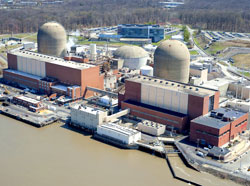NRC Carefully Assessed Issues Associated with New Pipeline at Indian Point
Posted by on November 19, 2015
Public Affairs Officer
Region I
Mention nuclear power plant and new natural gas pipeline in the same breath and it may not be surprising if some ears perk up.
 Such
was the case with a plan by Spectra Energy to install a
42-inch-diameter natural gas pipeline that would cross a portion of the Indian Point nuclear power plant
site, in Buchanan, N.Y. One of the most salient questions to arise has
been whether a rupture of the pipeline could adversely impact the safety
or shutdown of the two operating reactors at the site.
Such
was the case with a plan by Spectra Energy to install a
42-inch-diameter natural gas pipeline that would cross a portion of the Indian Point nuclear power plant
site, in Buchanan, N.Y. One of the most salient questions to arise has
been whether a rupture of the pipeline could adversely impact the safety
or shutdown of the two operating reactors at the site.The NRC’s conclusion, based on a thorough peer-reviewed analysis, is no.
First, however, it’s important to understand the limitations on the NRC in this complex interstate project. The agency’s role is restricted to ensuring the safe operations of the Indian Point facility; we cannot usurp the roles and responsibilities of other federal, state and local government agencies.
Other agencies involved in the proposed pipeline expansion include the Federal Energy Regulatory Commission (FERC), which is the lead agency for evaluating applications to construct and operate interstate natural gas pipeline facilities; the Pipeline and Hazardous Materials Safety Administration of the Department of Energy; and the Environmental Protection Agency. There are also many state and local government agencies that have separate responsibilities.
Indian Point has for decades had two natural gas pipelines – one 26 inches in diameter and the other 30 inches– running through the property. The Algonquin Gas Transmission Co., a subsidiary of Spectra Energy, built the 26-inch line in 1952 and the adjacent 30-inch line in 1965. Operating licenses were granted to Indian Point Units 1, 2 and 3, in 1962, 1973 and 1975, respectively. The new line would be installed across a more southerly section. (Plans also call for the 26-inch line to be removed from active use at the time the new line begins operating.)
The 42-inch line would not be located within the plant’s Protected Area – the highly secure section where the reactor buildings, spent fuel pools and other key structures are located. Instead, it would traverse the site about a quarter-mile from the Unit 2 and 3 reactors.
There will also be special precautions to enhance the safety of the piping that will be located closest to Indian Point to further limit the already very low potential for a gas pipeline rupture. For one, the steel pipe will have a wall thickness of almost three-quarters of an inch and will buried at least 4 feet deep, under engineered backfill. The line will have additional corrosion protection and all of its welds will be carefully examined.
Reinforced-concrete protective mats will also be placed over the section of the pipeline closest to Indian Point, providing additional physical protection. Warning markings will drive home the message that excavation in that area is a bad idea. Accidental ruptures during excavation work are one of the most frequent causes of pipeline failure.
Entergy Nuclear Operations Inc., the plant’s owner/operator, was required under NRC regulations to perform a site hazards analysis to evaluate how plant operations could be impacted by a rupture of the pipeline. The company determined the plant could safely shut down and, more broadly, that the pipeline would not pose an undue risk in terms of the facility’s safe operation.
 The
NRC did not accept this analysis at face value. The agency conducted an
independent confirmatory analysis. This evaluation, which assumed a
complete rupture of the pipeline, concluded the plant could either
continue to safely operate or temporarily shut down.
The
NRC did not accept this analysis at face value. The agency conducted an
independent confirmatory analysis. This evaluation, which assumed a
complete rupture of the pipeline, concluded the plant could either
continue to safely operate or temporarily shut down.In addition, NRC inspectors performed visual assessments of the proposed pipeline routing to confirm assumptions used in Entergy’s analysis report. They also reviewed the qualifications of the contractor who carried out the company’s analysis and that Entergy’s acceptance of the report was consistent with its quality assurance program standards.
A discussion of the NRC’s inspection and analysis can be found in an inspection report issued on Nov. 7, 2014. In it, the NRC staff states that “the staff determined Entergy had appropriately concluded that the proposed pipeline does not introduce significant additional risk to safety-related structures, systems and components at Indian Point Units 2 and 3, and therefore the change in the design bases external hazards analysis associated with the proposed pipeline does not require prior NRC review and approval.”
After consideration of all of this information, the NRC determined the two Indian Point reactors could safely operate or shut down if a rupture were to occur on any portion of the proposed pipeline where it would traverse Entergy’s property. The NRC shared these findings with FERC. That agency approved Spectra Energy’s proposal to build the expanded pipeline on March 3, 2015, and authorized construction in the vicinity of Indian Point on Sept. 24, 2015.

No comments:
Post a Comment